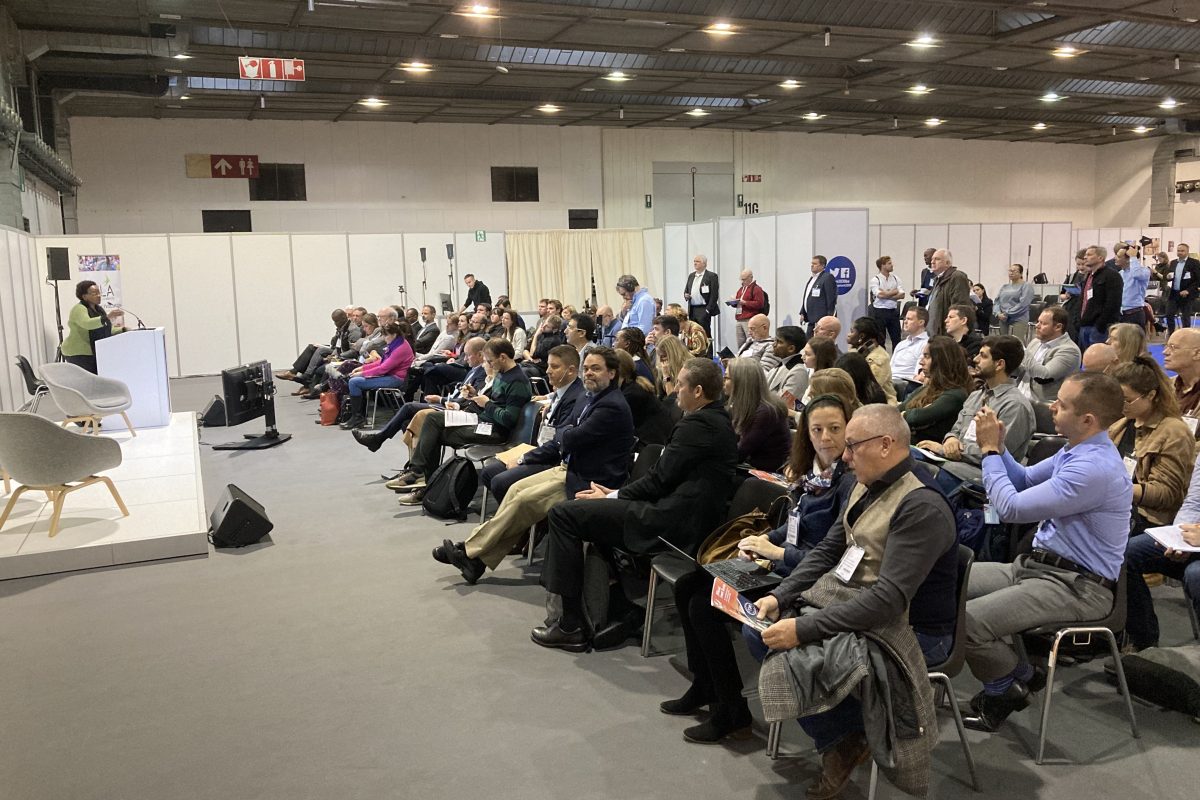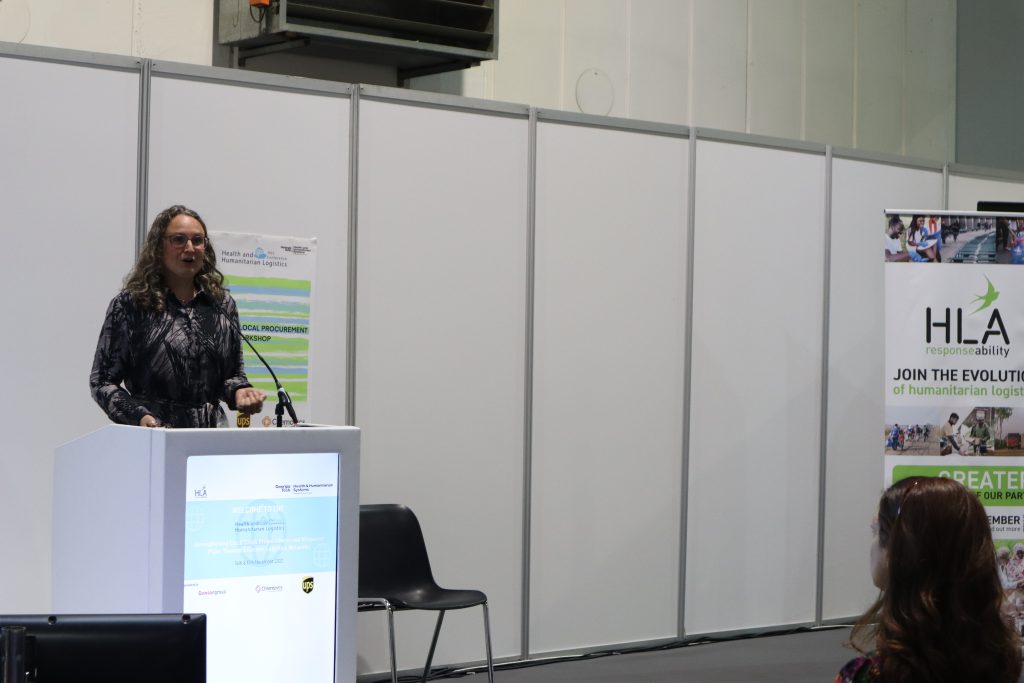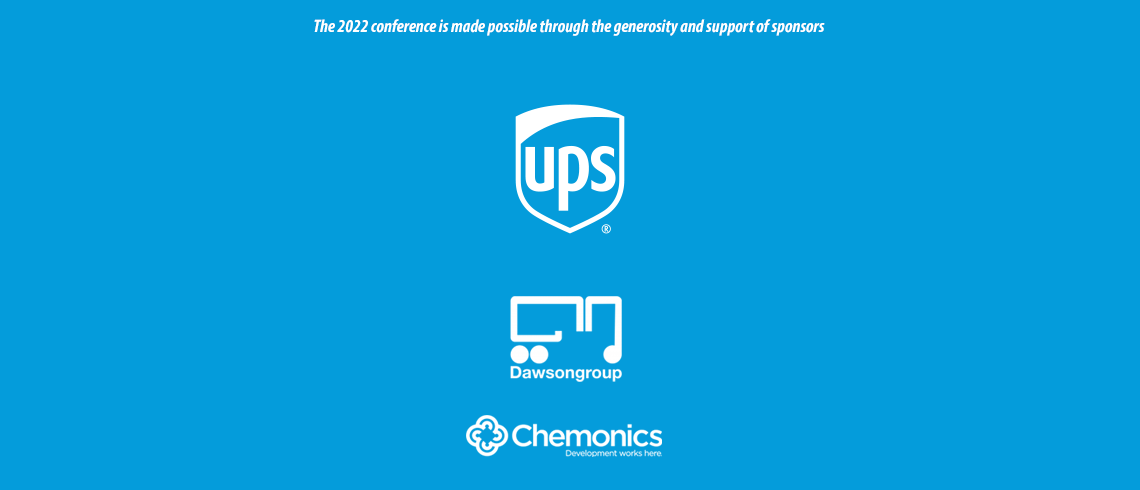Highlights from HHL2022
The 14th Annual Health & Humanitarian Logistics Conference
This year’s conference was made possible thanks to generous sponsorship from
The UPS Foundation
and supported by
Dawson Group Ltd. and Chemonics
DAY 1 (16.11.22)
Regional focus for morning session: Africa

Keynote: Dr Jesca Nsungwa Sabiiti, Commissioner of the Reproductive, Maternal, and Child Health Services for the Ugandan Ministry of Health.
Dr Sabiiti highlighted the current challenges facing Uganda in meeting its Millennium Development Goals. The MoH has developed several strategies to reach the historically underserved and growing refugee populations, as “most of our programs and technologies now are trying to understand the logistics systems to reach the last mile to support the delivery of community health programs.” Dr. Sabiiti mapped out 5 strategic shifts specific to the health strategy for women and children, which included emphasizing evidence-based solutions and geographic sequencing to focus on higher-need areas. She noted the lessons learned from the COVID-19 pandemic, which included the need to increase local production and storage capacities, as well as an urgency to develop real-time decision-making processes to increase Ugandan supply chain self-reliance. (view slides)
A key lesson learned from the pandemic, is that Uganda must depend on adaptive development, adaptive transport, and capacities. Work is needed to build local capacities for producing and managing medical items, as well as long term development for real-time decision making with minorities designing some of these strategies.
Panel discussion – Alan Braithwaite, Chair, Catalyst 2030 Group moderated a panel discussion. Panellists were:
- Claire Barnhoorn, CEO, Solvoz – discussed progress / challenges to sustainable local procurement and operational support for procurement capacity development. She explained that Solvoz enables local procurement by providing access to an international register of 300,000 suppliers across the full range of categories. Solvoz also provides good practice guidance on specification and contracting, covering its costs through subscriptions from buyers.
- Scott Dubin, Advisor, Supply Chain Private Sector Engagement, Global Health Fund, discussed health supply chain capacity development, supporting governments to outsource logistics services (view background slide)
- Dr Rudi Pauwels, Chairman, Praesens Foundation – discussed last mile delivery and presented the Prasens Care rapidly deployable mobile medical lab (view slides)
Participants formed 3 breakout groups moderated by Haydn Sandvig, Logistics Learning Alliance
- Andrew Lamb facilitating discussion on Sustainable Local Procurement
- Silvia Rossi Supply Chain Officer, UN WFP on Health Supply Chain Capacity Development
- Judi Heichelheim, Senior Vice President, Global Health Supply Chain Program, Chemonics on Last Mile Delivery
The breakout groups noted the importance of developing collaborative learning opportunities between stakeholders / sectors. Many challenges faced in the developing world are similar to those faced in regions such as Europe, where during the pandemic there have also been issues related to supply forecasting. Supply chain capacity is also a global challenge. For example, for the manufacturing of medical commodities, and the need to ensure the right standards are being applied.
For transport and logistics, there is now a greater focus on the use of local commercial sector capacity, and a stronger willingness to outsource service delivery needs. For the future of health supply chains, there must be a greater focus on sustainability, as well as and gender inclusivity.
Afternoon session:
Special Topic: Supply chain learning from Ukraine response Roundtable Discussion
Moderator: Neil Rodrigues, Sr. Director, Global Supply Chain Operations, IRC
Learning from Ukraine response highlighted the importance of working and collaboration. Sue Hodgson from Save the Children International explained the challenges of initial staffing shortages and having to quickly scale up operations where many international organisations were not registered. However, product availability was not a problem but working under UK / EU contracts and expecting Ukrainian suppliers to abide by humanitarian principles was not realistic.
Unsolicited donated products / GiK was a big issue and bonded warehousing was needed but not initially available; the Logistics Cluster played an important role on setting up storage. There was positive engagement with the Ukraine Government / Oblasts, and Amazon was a key partner to support all deliveries to national partners. The future should be to collaborate with a large commercial partner.
Colin Credle and Gordon Brown from Chemonics shared their experiences in delivering ARV Supply Chain support, again highlighting the importance of good communications and effective risk management. Kat Sellers from Needs List found that data protection is a big problem and local organisation needed support to be vetted prior to onboarding with the Need List platform that provided opportunity to match needs with supplies available. (view slides)

Kat Seller presenting on Ukraine
Dr Serhan Tuglular, Marmara University, with Prof Burcu Balcik, Ozyegin University shared their perspectives and experiences in supporting dialysis treatments in Ukraine; providing dashboards and a user interface to visualise solutions. A dialysis task force was set up to keep knowledge and information fresh. Again, the importance of collaboration cannot be overemphasised. (view slides)
Andrew Lamb – Chair, Internet of Production Alliance has been mapping the world’s machines. Technology has helped to disintermediate a huge amount of activity in many sectors. Ukraine is/was a manufacturing hub for the world. They have maker spaces and fab labs across the country. There is a big maker movement. He has been working to support mobile maker spaces in Ukraine – going to schools or hospitals to make things. The Local Procurement Learning Partnership (LPLP) is now a thematic area of HLA to share lessons. Internet of Production is collaborating with the LPLP.
DAY 2 (17.11.22)
Regional focus for morning session: Asia

Keynote #1: Anna Lowe, Chief Catalyst of Manufacturing Change
Anna Lowe presented the first keynote address of day 2. She asked the audience to consider the possibility of local manufacturing in contexts other than emergency measures during a global pandemic – local manufacturing would not only decrease travel distances and energy used for different goods, but also decrease problems like medical devices being unfit for local populations. Although local manufacturing comes with its own set of challenges, she stated “these are not insoluble problems, and if they are now, they are not if we look at what might be possible in 10 years if we start working towards this now”. To succeed, the concept of local manufacturing needs expertise to create and implement solutions, funding, and most importantly, willingness to change. Three main areas that will require these changes are: how procurement is done, how products are unnecessarily specified, and that local manufacturing facilities will require more support for communities to become more self-sufficient. Two success stories, brought about by the pandemic, include the manufacturing of hand sanitizer by many diverse facilities around the globe, and Hero Shield, a mask produced in volumes of 10,000 per week, due to the collaboration of manufacturers in Bangladesh.
By having things made locally, you can avoid problems like culturally inappropriate toilets or stretchers that are too short for the people in the region. Areas that need to be thought about differently include how procurement is done, and how manufacturers can be supported as a standard part of emergency responses. (view slides)

Keynote #2: Paul Molinaro, Chief, Operations Support and Logistics, WHO
Paul Molinaro discussed WHO’s inspiration and necessity their Health Emergency Preparedness Response and Resilience Architecture (HEPR). Paul noted that although the global ability to sequence the coronavirus, produce and distribute vaccines would have been near impossible 5 years ago, during the pandemic “there were gaps and there were issues – the main ones being around equity and equity of access to things we were able to produce in the world.” He presented the 5 C’s of essential system improvements based on lessons learned to improve future equity: (1) collaborative surveillance programs, (2) community engagement and participation, (3) care that is safe and scalable for healthcare workers and patients, (4) coordination between nations, and (5) countermeasures that are accessible. Lastly, he spoke to his expertise in operations and logistics, and listed the 6 capabilities of supply chains that must be strengthened. These are: a collaborative emergency list between regions and nations; being able to predict demand and buffer for demand; an ability to allocate scarce resources effectively and as equitably as possible; well defined procurement policies; balanced stockpiling at different governmental levels, and; a swift and resilient distribution system. (See Annex)
Panel discussion – Alan Braithwaite, Chair, Catalyst 2030 Group moderated a panel discussion. Panelists were:
- Kuldeep Bandhu Aryal, Social Innovation Fellow, Field Ready presented on progress and challenges to sustainable local procurement and local production using bucket molds in Bangladesh
- Judi Heichelheim, Senior Vice President / Global Health Supply Chain Program, Chemonics discussed health supply chain capacity development targeting women & girls as well as transformational healthcare changes
- Andrew Parkes, Global Supply Chain Director, Relief International discussed the last mile delivery challenges of working in Fragile States
The sense from all speakers was that there is an underlying fragmentation in aid supply chains. We need more private sector partnerships in differing contexts. There isn’t one global solution. Health surveillance is needed at community level as this is an area that has been neglected. The Covid response worked better in developing countries, where there are more clearly establish community communication mechanisms, than in a centralised system in developed countries. However, some sort of data ‘bill of rights’ for the use of Apps is needed to ensure better data protection. Timely information for decision making is key.
Participants formed 3 breakout groups moderated by Andrew Lamb, Chair, Internet of Production Alliance
- Nirpa Dhami, Regional Supply Chain Advisor (SE. Asia) World Vision Intl. remotely presented and discussed sustainable local procurement and production (view slides)
- Emad Nasher, Turkey Programme Lead (Syria response), Sahaya Hazir, presented health supply chain capacity developments and making essential medical items in Syria (view slides)
- Marin Tomas, Senior Advisor for Logistics & Supply Chain, International Medical Corps facilitated a workshop on last mile delivery (view slides)
Key outputs from the groups were:
- Data standardization and data collecting infrastructure is key to improving supply chain visibility
- Segregation of duty (Program vs. Logistics) is still an ongoing challenge
- Off the shelf products don’t necessarily fit to humanitarian operations
- Technology is not barrier, it is processes…
- There need to be greater willingness to share information between organizations. Collaboration a must – thinking independently in supply chains does not work
- Using private sector support and knowledge to improve last mile deliveries is a key future requirement
- Smart ordering based on actual end user needs (partnering with Amazon as an example)
- Consider renewable energy / power requirements and the use of technology in remote locations
- Funding for crisis preparedness and response is in crisis itself! Financing needs to be more sustainable. A holistic approach to funding should include resilience programming
Afternoon Session:
Special Topic: Enabling Technologies Roundtable Discussion
Moderator: Alan Braithwaite, Chair, Catalyst 2030 Group
Florent Chane, Project Mgr, ESUPS & Jason Aclmovic, Assoc. Prof. Penn State University presented the Stockholm Platform (prepositioning relief supplies) which helps agencies with optimised pre-positioning of inventory and gives cross agency stock visibility and sharing. One of the exciting insights was the ability to forecast the scale and nature of disasters and aid needs – even if the timing is more difficult. The idea of making that ‘pool’ of stock visible to all in terms of items and locations across agencies is a truly collaborative opportunity. (view slides)
Shelley Taylor, Founder, Trellyz presented two complementary apps which enable real time demand and supply matching across logistics, public authorities, humanitarian and emergency situations. This is a non-hierarchical and open architecture solution that enables many-to-many relationships between the agents/actors in the network. (view slides)
Marin Tomas & Dr. Yazeed Ayasra, Director Health Systems Applications, IMC, presented PIMS (Pharmaceutical Information Management Software)a solution which provides medical practitioners in development and disaster situations with fully compliant patient and pharmaceutical admin support. The requirements of medical systems are very special: batch control, right medication, right application etc. It was inspiring to learn that the aggregated data had provided advance warning of a serious outbreak of disease and enabled appropriate actions to be taken. (view slides)
Muhammad Azmat, Asst Prof in Logistics & SC Mgt. Aston University presented on the utilisation of drones in aid delivery, search & rescueintroducing the idea of autonomous drone swarms to put capacity on the ground quickly with limited needs for controllers and much reduced risk vs other methods. He made the point that so much airdropped aid is damaged and unusable where in contrast a swarm of drones could overcome that difficulty and be manageable from a control point of view. Clearly, there is more to do here, but the opportunity is exciting. The experience of the Ukraine war has served to emphasise the potential of drones in a whole range of less humanitarian situations but the parallels of surveillance and delivery are universal. (view slides)
Frank Van Gelder, Secretary General, Pharma.Aero presented the HLA / Pharma Aero drone case study project demonstrating the integrated pharmaceutical response in the pandemic that he organised with the EU through Pharma.aero. The last mile achievement, getting vaccines into difficult places, relied on drones to deliver packs of vaccines in temperature compliant conditions in the harshest of environments. 10 years ago, it would have been impossible to envisage such an initiative for the last mile, let alone the end-to-end supply chain coordination. (view slides)
It was clear that these platforms have the potential to complement rather than compete and that there were opportunities for parallel application in the same setting as well as interoperability. It will be the challenge of field operations to configure how they may be able to leverage the potential – collaboration and process skills will be part of that business model innovation.
Annex
WHO Presentation Outline
Health Emergency Preparedness Response and Resilience Architecture (HEPR)
Why?
- Pandemic preparedness had been done before COVID-19, but there is a lot to learn from the pandemic
- There are many things we did that we could never have done 5 years ago
- Genetic sequencing within a month
- “Vaccines being developed and released within months rather than years is a huge step forward”
- 3 pillars for improvement: coherence, equity, and inclusion
- Governance / coherence
- Commitments for State parties to adhere to current regulations and governance are in the process of being revised
- Financing
- World Bank – creation of the financial intermediary fund
- WHO central fund for emergencies
- Systems – 5 C’s based on lessons learned:
- Collaborative surveillance (nervous system – genetic sequencing, detection)
- Community engagement and participation – people are contrarian
- Care – safe and scalable, protection for healthcare workers and patients
- Coordination – national action plans
- Countermeasures – equitable access to medical countermeasures
- Countermeasures – number of subsystems
- Faster and more adaptable research and development
- Regulatory environment around licensing
- Distributed and scalable manufacturing
- It’s not possible to make everything locally, but we could see what could be done at a regional grouping level
- At response time – “coordinating multiple channels of supply and really trying to make sure that leads to equitable access”
- Faster and more adaptable research and development
- 6 capabilities of supply and logistics
- Emergency list – what are the critical countermeasures a country needs due to this risk or threat?
- What is the demand and what is the need, both in terms of forecasting and in terms of demand coming up with financing behind it? Aggregating that and being able to give signals to industry, is what we need but is a very difficult thing to accomplish
- Ability to allocate and prioritize in the face of market constraint
- Needs to be transparent and well understood
- Procurement – contracts, where do we buy from? What are the protocols to share data?
- Stockpiling
- Distribution system
HHL2022
About the Conference Series
The Health and Humanitarian Conference series is organized each year by the Center for Health and Humanitarian Systems (CHHS) at Georgia Tech in partnership with INSEAD, MIT, and Northeastern University, with generous support from corporate and other organizational sponsors.
Stay Connected on:
Contact
For general information about the conference, including registration, please use our contact form or the below:
- humlogconf (@) gatech.edu
- 755 Ferst Drive, Atlanta, GA 30332










